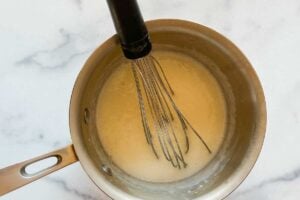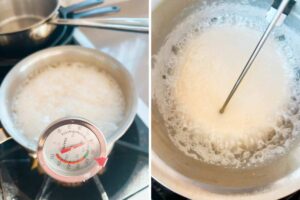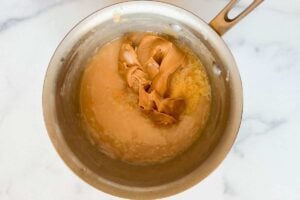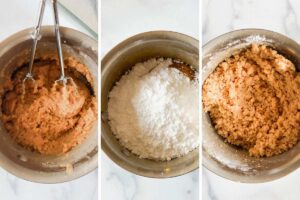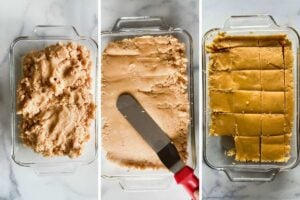Classic + Creamy Peanut Butter Fudge
I love making fudge because it’s strangely impressive but way (way!) easier than cookies. You’re just cooking stuff in a small pan and pouring it. Cookies wish they were that easy. This peanut butter fudge is one of my favorites. It’s sweet, creamy, and a tiny bit salty. Best of all, you don’t need any weird ingredients. You probably have everything you need right on hand.
Peanut Butter Fudge
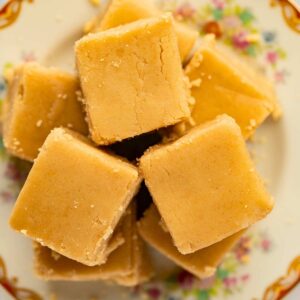
Equipment
- 2 quart saucepan
- Whisk
- Hand mixer
- Buttered or parchment-lined dish
Ingredients
- 2¼ cups granulated sugar
- ½ teaspoon salt
- ⅔ cup half and half
- 1 tablespoon corn syrup
- 2 tablespoons butter + additional tablespoon for greasing pan
- ¾ cup creamy peanut butter
- 2 cups powdered sugar
- 1 teaspoon vanilla extract
Save This Recipe
You'll join my email list which you will love. And if you don't, unsubscribe in one click. ❤️
Instructions
- Combine and heat. In a 2-quart saucepan, mix the sugar, salt, half and half, and corn syrup. Whisk until smooth, then place over medium-low heat and bring the mixture to a gentle boil.

- Cook to 240°F. Attach a candy thermometer to the side of the saucepan. Allow the mixture to cook undisturbed (do not stir) until it reaches 240°F. Immediately remove the saucepan from the heat.

- Add butter and peanut butter – do not stir. Let the mixture sit until it stops bubbling. Add 2 tablespoons of butter, the peanut butter, and the vanilla extract on top. Do not stir; let it cool at room temperature for 20 minutes until the pan is warm but not hot to the touch.

- Beat the fudge. Use a hand mixer at medium to low speed to beat the mixture for 1-3 minutes until it thickens and becomes smooth. Add 2 cups of powdered sugar and beat in. It will appear crumbly: this is normal!

- Press, cool, and cut. Press the fudge into the buttered dish, smoothing it out as needed. Let it set for about 20 minutes at room temperature. Once set, cut into one-inch squares and enjoy! It will be softer than most stovetop fudge because of the peanut butter, but it will still cut into nice squares.

Notes
- Make sure your peanut butter is creamy and smooth for the best texture. Avoid natural peanut butter with separated oil.
- Wipe down sugar crystals from the sides of the saucepan with a damp pastry brush while heating to keep the fudge smooth.
Nutrition
What makes this fudge work is temperature and timing. You really need a candy thermometer here, although I know it’s a little annoying to buy one more thing. But they’re affordable and you can use them for deep frying too.

The resting period after cooking is important too. You want the ingredients to cool enough so that when you beat them they become smooth and creamy, not a gloppy mess.
A Newsletter you’ll love
Daily recipes from the farmhouse, Sunday meal plans, seasonal ideas, straight from my kitchen to your inbox.
I promise to keep your email address safe. Unsubscribe at any time
Tips for Success
Keep the heat at medium-low throughout the cooking process. Rushing the cooking time gives you the enemy: grainy fudge.
When beating the mixture, it will look crumbly and weird and like it can’t possible work. It will work!
For the cooling step, wait until the pan is warm (not hot) to the touch. You should be able to hold your hand on the bottom comfortably.
If you live above sea level, read here to learn about candy-making at high altitudes.
Ingredients and Equipment
Peanut Butter: Use commercial brands like Jif or Skippy. Natural peanut butter is great–but not for this. I personally prefer Jif creamy. Try my old-fashioned peanut butter balls if you’re a peanut butter lover like me.
Half and Half: It has the right amount of fat. You can substitute equal parts heavy cream and whole milk if needed.
Corn Syrup: Prevents crystallization. I feel like we’ve been over this. (Light or dark both work fine.)
Candy Thermometer: You need it! Don’t guess!
Make It Your Own
It’s like a sweet candy dough. Let’s put stuff on top!
- Use almond or cashew butter (commercial versions only)
- Add a chocolate layer
- Top with flaky sea salt, mini chocolate chips, or crushed pretzels
Common Questions
No that would be super weird. The texture will be strange, and it can affect how the fudge sets.
Usually, this means the mixture didn’t reach the proper temperature (240°F). Make sure your candy thermometer is calibrated correctly and isn’t touching the bottom of the pan. Also, humidity can affect the setting – on very humid days, you might need to cook to 241°F.
Do not be intimidated by candy making. It is no big deal. I hope you love this recipe and it earns a spot in your holiday sweets traditions.

Love,



